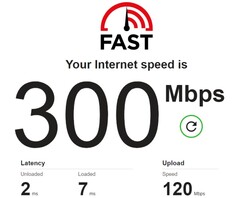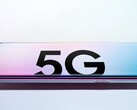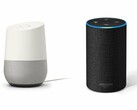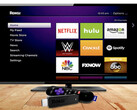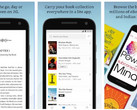A brief history of internet connectivity
At the end of the 1960s, when the ARPANET project was born, the connection speeds were in line with the hardware available back then — a mere 56 kbps. In the late 1990s, the internet connections now available to the public usually operated at up to 10 Mbps, with modems limited to the same 56 kbps speed.
1994 was the year when the first International Conference on the World Wide Web took place. In 1995, internet access was very limited: 0.04 percent of the world's population was able to go online, and well above half of them were located in the United States. In less than two decades, the tiny number mentioned above went all the way to 41 percent (2014).
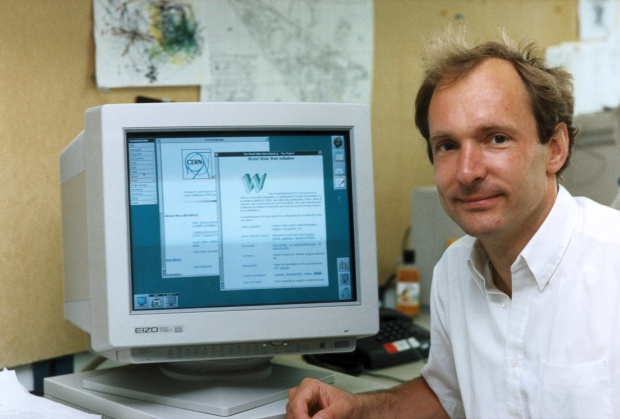 The inventor of the World Wide Web, Tim Berners-Lee
The inventor of the World Wide Web, Tim Berners-Lee
Fast forward to 2019 and we get global mobile 4G coverage, fiber connections that offer at least 300 Mbps and often hit 1 Gbps for a fraction of the price of a 56 kbps modem connection that was available in the 1990s, and usage scenarios that were only possible in SF movies three decades ago.
As a side note, in early 2004 my block of flats had no LAN connection and I was the first one to get a LAN connection. Thankfully, I got a solid 100 Mbps up/down connection for a very good price. Now I have a fiber connection that hits 300 Mbps down and around 150 Mbps up that I could upgrade to 1 Gbps for just a few bucks anytime — only that I do not feel the need for more speed yet.
Various internet usage scenarios and their evolution in time
Unsurprisingly, most of the data that was exchanged online in the early 1990s consisted of plain text files. However, shortly after the arrival of the World Wide Web, the internet became more than just text. Below you can find a few services that shaped the online landscape for the decades that followed, although most of them are now extinct or mere shadows of their former selves:
- Hotmail was introduced in 1996, offering a free email service that could be accessed anywhere, anytime. Microsoft acquired it just one year later for a reported US$400 million.
- ICQ arrived the same year as one of the first mainstream instant messaging services.
- Larry Page and Sergey Brin founded Google in 1998 but it all had started in early 1996 as a research project of these two. Google Search went live in 1997.
- Yahoo! Pager arrived in early March 1998 and became Yahoo! Messenger in late June 1999.
- Napster was introduced in June 1999, providing an easy way to share files — illegally, in most cases — and was shut down two years later, in July 2001. However, it laid the foundation for many decentralized peer-to-peer file-sharing services and apps, some of them still live in 2019, such as eMule and Shareaza.
- Facebook went live in the US in 2004 and worldwide one year later. Since then, it acquired popular products like Instagram and WhatsApp, adding them to its portfolio.
These highlights above are only drops in the ocean, since the internet has been changing at a tremendous pace over the last three decades and many areas had their peak moments and their falls.
Now, checking emails, using instant messaging services or seeking for answers to various questions with the help of a search engine does not require a very fast internet connection and 5 to 10 Mbps should be enough for these scenarios, right? However, most of the billions of people that go online on a daily basis often end up using bandwidth-hungry services:
- Video streaming — both on-demand and interactive live streaming (Twitch, Amazon Prime Video, Netflix, Mixer, and so on).
- Audio streaming (Bandcamp, Spotify, Jamendo, SoundCloud, Apple Music, Deezer).
- Video chat and live video tech support.
- File sharing — there are a few legal torrent sites (Legit Torrents, PublicDomainTorrents, and the extremely rich in content etree.org Community Bittorrent Tracker) with more than just Linux ISOs available, although most people think about illegal downloads when they hear about this.
- Digital game distribution platforms such as Steam or GOG, since many new games easily hit 50 GB or more in size.
- Home surveillance and remote interaction with various smart home appliances.
- The digital home workspace is becoming a reality for more and more people with each year thanks to the speed and ease of use of cloud-based solutions.
For all the scenarios above, the fastest internet connection one can buy is the only choice that would spare the user from wasting time simply staring at the screen, waiting for something to load.
 Modern home office
Modern home office
Starting way back in the early 2000s, working at home required a fast connection for both freelancers and those who were allowed to finish some work at home and upload it to their employer's servers as soon as they got the job done.
Around 2007, I was in charge of creating video tutorials for a US-based company, so having a fast internet connection helped a lot since my work obviously involved uploading those videos to the company's servers as well. Now, one can simply login via an encrypted connection and perform all the work directly on a remote server without running a single bit of code on the local workstation.
Last year's key statistics
Here are some essential internet usage-related figures for 2018:
- Average mobile speeds of 22.82 Mbps down and 9.19 Mbps up, which translate to 15.2 and 11.6 percent increase over the previous year.
- Fixed broadband average speeds of 46.12 Mbps down and 22.44 Mbps up, both showing a solid improvement of over 26 percent over 2017's values.
- Android devices were slower than iOS-powered ones, with 21.35 Mbps vs. 27.84 Mbps down and 8.73 Mbps vs. 10.61 Mbps up.
- The top 5 countries with the fastest mean mobile internet connections: Norway, Iceland, Qatar, Singapore, Netherlands, all within the 53.42 - 63.19 Mbps range for downloads.
- The fastest mean download speeds on fixed internet connections reached as high as 175.13 Mbps in Singapore, followed by Iceland (153.03 Mbps), Hong Kong (138.81 Mbps), South Korea (114.67 Mbps), and Romania (109.90 Mbps).
- The most solid improvements in download speeds over 2017 were recorded in Costa Rica (13.40 Mbps, 194.6 percent growth) for mobile and Paraguay (27.05 Mbps, 268.6 percent growth).
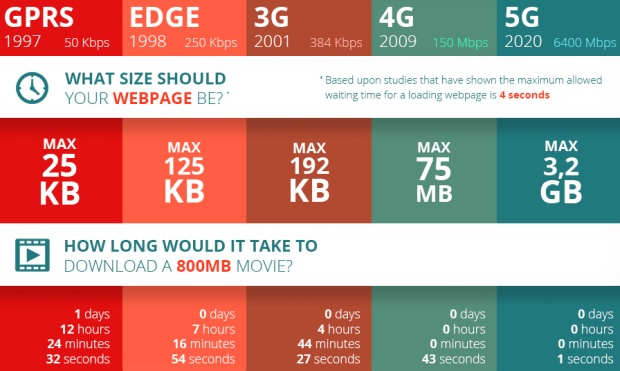 Evolution of mobile internet speeds from 1G to 5G (Source: TechSpot)
Evolution of mobile internet speeds from 1G to 5G (Source: TechSpot)
Future challenges and expectations
- Virtual reality and augmented reality applications will increase the demand for fast mobile connections in the coming years.
- The need for faster fixed connections will be driven up by the increasing resolution of video content that is being streamed, but also by the arrival of next-gen services like Google Stadia.
- As voice recognition and AI-driven virtual assistants get better, mobile devices will require faster connections as well. Using natural language to interact with the phone and with all mobile apps is quickly becoming something ordinary.
- A switch from live TV streaming to more — and sometimes exclusively — on-demand content. The drop in cable TV subscriptions and the increasing popularity of services like Netflix shows that consumers want to be in control and are often willing to pay extra for this privilege.
- Smart home and autonomous vehicles will become more popular and 5G adoption will speed up.
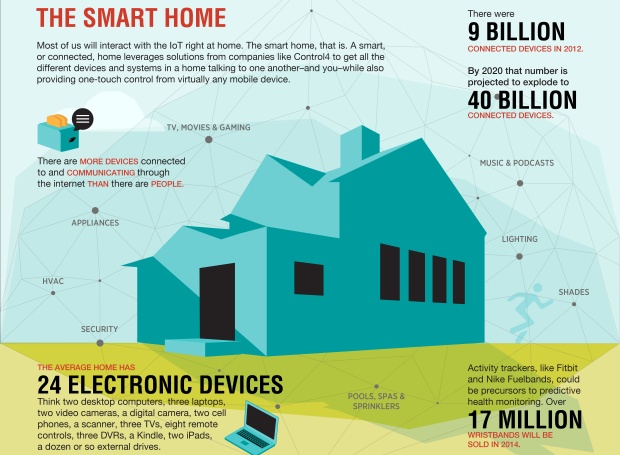 Smart home ecosystem
Smart home ecosystem
More than just the above, the "Internet of Things" concept will include smart clothing, an ever-increasing array of sensors that would be connected to remote servers for providing a better life overall. For example, think about protective gear with shock and heart rate/blood pressure sensors embedded that automatically calls the emergency services when its user falls off the bike and fails to get back up in a few seconds. Obviously, the use of such technology always comes with privacy concerns, but the benefits outweigh the possible problems by far.
Most tasks that had previously been performed exclusively on desktop computers and fixed connections a decade ago will go mobile, with a focus on applications that run entirely on a remote server (see the digital workspace discussion above or the part on Google Stadia that starts with the paragraph below).
If you missed the news related to it, you should know that Google Stadia — previously known as Project Stream — promises to be the next wonder that will change the online world. The entire service will focus on installing and running games in the cloud, thus allowing subscribers to actually run various titles they wouldn't be able to run locally on their machines, also helping them to save on the electricity bill in the process. After all, streaming a video feed, even an interactive one, is less demanding on a computer than running a game that pushes most hardware components to the limit.
Google Stadia is capable of running games at up to 4K resolution and 60 fps, so its requirement for a high-speed, low-latency internet connection are obvious. Other big names in the industry are taking cloud services and cloud-based gaming very seriously as well — Sony's PlayStation Now has been around since 2014 and Microsoft's upcoming Project xCloud should hit the market later this year.
Conclusion
While reading emails and news can still be done while using less than 1 GB of data for an entire month, most internet-related tasks involve multimedia content nowadays and need a low-latency connection. This is not only about gaming and video streaming since a reliable and fast connection is also vital for controlling smart home appliances or trading stock online.
What can you tell us about your history of internet usage and the connection speeds you had over time? Are you happy with what you get today? Do you think your internet usage patterns will change with a solid increase in speed? Feel free to drop your thoughts in the comments section because there is still a lot to talk about with this topic.
Source(s)
Own
The World's Internet in 2018: Faster, Modernizing and Always On (Speedtest Stories & Analysis: Data-driven articles on internet speeds)
A brief history of the internet over the past 20 years and the role of the World Wide Web (ABC News)
The future of Internet: The world of tomorrow is on its way (eHorus)
List of countries by Internet connection speeds (Wikipedia)
Internet access (Wikipedia)


 Deutsch
Deutsch English
English Español
Español Français
Français Italiano
Italiano Nederlands
Nederlands Polski
Polski Português
Português Русский
Русский Türkçe
Türkçe Svenska
Svenska Chinese
Chinese Magyar
Magyar